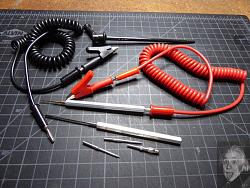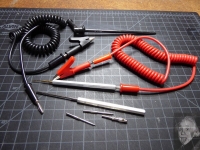I use my VOM a lot, mostly with low-voltage hobby work. I'm impatient and hate the hassle of long tangled probe leads and constantly having to change from points to pinchers to hooks. So I spent a lot of time optimizing my leads to the way I work.
The first thing was to obtain permanently coiled leads (like the older telephone handset cords) and fit them with 4 mm banana plugs at each end. With this arrangement I don't have to screw and unscrew the devices at the end of the cords as is the case with many commercially available sets. I managed to find some extra long spring-loaded hooks that accept banana plugs and a commercial set yielded some grippers with a much wider "gape" than an alligator clip.
Still missing was a set of banana probe handles that could take all the probe points I'd acquired over the years. Most of these have a M 3 x 0.5 thread.
A length of 1/4" hex aluminum from the junque boxes provided two 3.5" handle lengths. These were drilled at one end to accept a banana plug and drilled and tapped for M3 threads at the other.
I'll insulate the handles with shrink wrap if the junque box doesn't yield any suitable lengths of silicone tubing. On the rare occasions when I work with the scary stuff like 220, I have a set of commercial heavy duty leads that I use. I won't trust my homemade handles any farther than I trust the stuff that came with the VOMs.



 LinkBack URL
LinkBack URL About LinkBacks
About LinkBacks


 Reply With Quote
Reply With Quote




Bookmarks